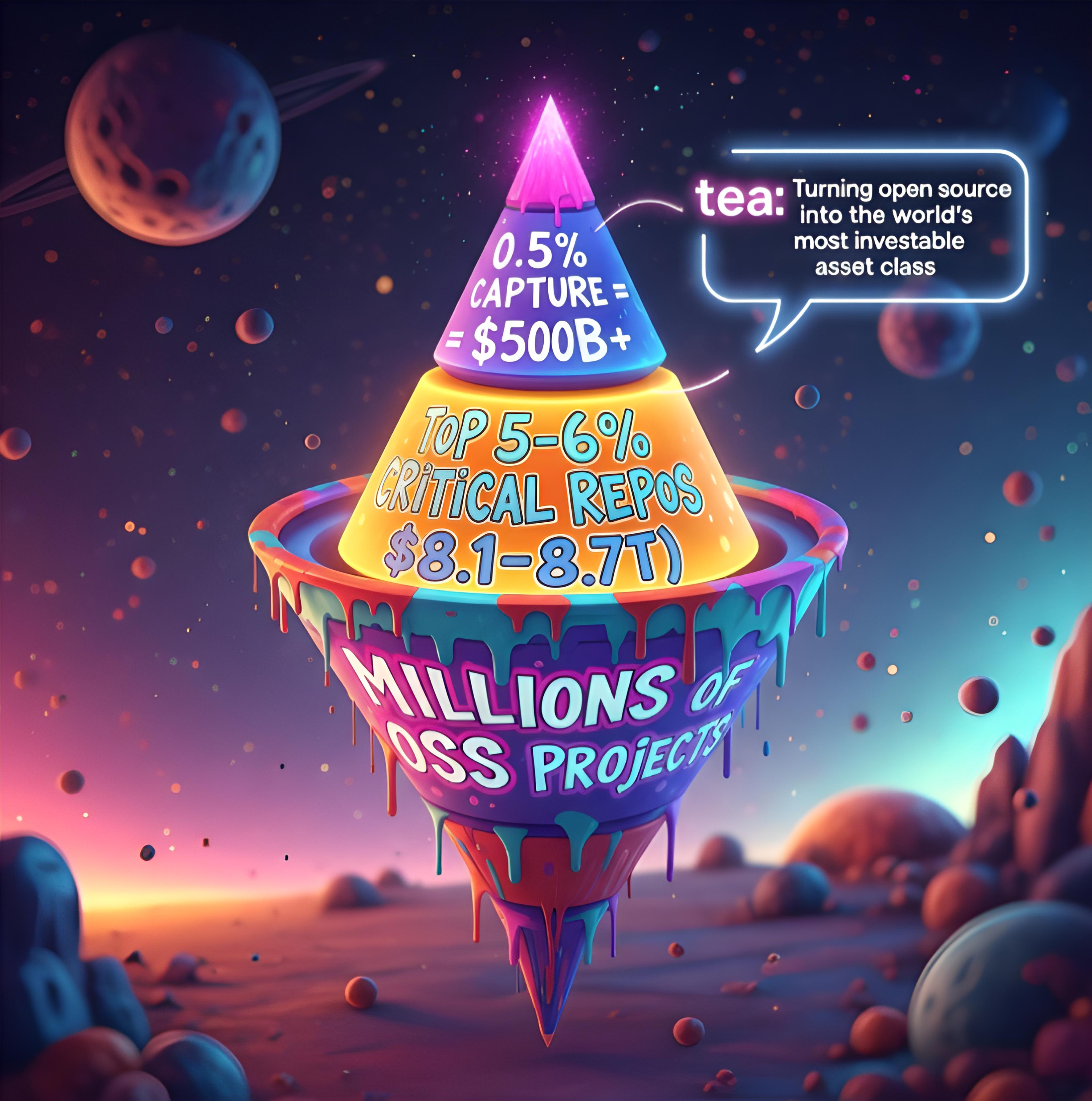$8.8 Trillion: Capturing Demand-Side Value in the Open Source Economy for the AI Era

TL;DR
Open source underpins $8.8 trillion in demand-side value, but developers see almost none of it. Tea is building the standards, rankings, and tokenization needed to reward the top 5–6% of projects that matter most. Capturing even 0.5% of that layer is a $500B+ opportunity. Launch is imminent, and this is the moment to be early.
The Elephant in the Room
$8.8 trillion.
That’s the estimated demand-side value of software that flows through open source today.
And yet, most developers powering this economy get nothing. Not a salary. Not a royalty. Not even a thank-you note.
Now, in the AI era, this imbalance has become existential. The models writing code, the apps scaling overnight, the tools guiding our daily lives all run on open source dependencies. If those layers crack, the whole system crumbles.
We’ve treated open source as “free” when in fact it’s the foundation of everything. That $8.8 trillion isn’t floating in the air, it rests on the backs of developers. It’s time to change how that value gets captured and distributed.
Context: Why Open Source Has Always Been Undervalued
Back in 2013 I met Max Howell at the height of Homebrew, the package manager that made Mac development usable for an entire generation of engineers. By any measure, Homebrew was one of the most widely-contributed open source projects of its time.
The rewards? A blanket from Google. An iPad from Square (now Block). And a Patreon that peaked at $55 a month, less than the price of one dinner in San Francisco.
Meanwhile, billions of dollars of enterprise value were built on top of his work. That’s the absurdity of open source today: trillions in demand-side value, near-zero supply-side compensation.
When Max and I came together again to build tea, it was with a singular mission: stop letting open source get exploited and finally start rewarding the builders.
Deep Dive: Capturing the $8.8 Trillion
Not all of open source carries the same weight. Out of millions of repositories, only a small fraction matter. Call it 5%–6% of projects providing nearly all the value. The rest are forks, experiments, or abandoned code.
At tea, we’ve built the infrastructure to tell the difference.
- chai oracle: our ranking engine that identifies the packages that truly matter. Out of 16,000 repos registered during testnet, only a few hundred achieved a meaningful teaRank.
- GPG precompile: cryptographic validation down to the commit level. No vanity repos, no fake commits, just proof of real work.
- PKGX: our next-gen package manager, already using AI workflows (by companies like HuggingFace), forming the backbone of our universal app store.
During our testnet, over 610,000 GitHub accounts registered. That’s not theory, it’s a developer army saying: “Yes, this matters.”
What we’re building is the standard for tokenizing open source. Standards bring liquidity. Liquidity brings value. And value finally realigns incentives from “exploit” to “sustain.”
Why Now: The AI Era Raises the Stakes
AI is a Cambrian explosion of software. Every week new agents, context-engineering tools, and vibe-coding apps appear. But every one of them relies on open source dependencies, thousands of packages deep, that were never funded, audited, or secured.
The App Store and Google Play can’t save us. Their walled gardens were built for Web2. They don’t have the tools to validate dependencies or secure AI models.
That’s our job.
If we don’t act now, AI will scale on a shaky foundation. A brittle future, with cascading vulnerabilities and a handful of centralized gatekeepers calling the shots.
Open source has to change before AI eats the world.
Why It Matters?
Communities
Are
Value
The overwhelming majority of the $8.8 trillion in demand-side value is concentrated in the top 5–6% of open source projects. That fraction carries nearly all the load, around $8.1–8.7 trillion worth of infrastructure.
We don’t need to capture all of it.
If tea captures even 0.5% of that top tier, that’s a $500B+ opportunity.
That’s what makes this so powerful for investors and traders. The upside doesn’t require conquering all of open source, only building the standards and liquidity around the most critical packages, the ones AI and modern software can’t live without.
This is where OSS developers, investors, and traders converge:
- Developers get rewarded for their real contributions.
- Investors gain exposure to the most valuable layer of infrastructure in the world.
- Traders finally get a liquid, standardized market around OSS value.
This isn’t just redistribution. It’s the foundation of the open source economy for the AI era.
Call to Action: Be Early, Stay Early
The launch of tea is imminent. By the time you’re reading this, our utility token may already be live on exchanges.
This is your chance to be early, not just on another network, but on the infrastructure that will define how open source sustains itself in the AI age.
Join our mailing list. Follow us on Twitter. Participate in the pre-sale. Build with PKGX. Stake into chai.
The fences are coming down. The gatekeepers don’t get to own this future. We do.
Communities have always been the hidden force of value in open source. With tea, that value is no longer hidden. It’s captured, distributed, and secured, together.
🔥 This is your moment. Don’t just watch the $8.8 trillion economy form, help build it.





